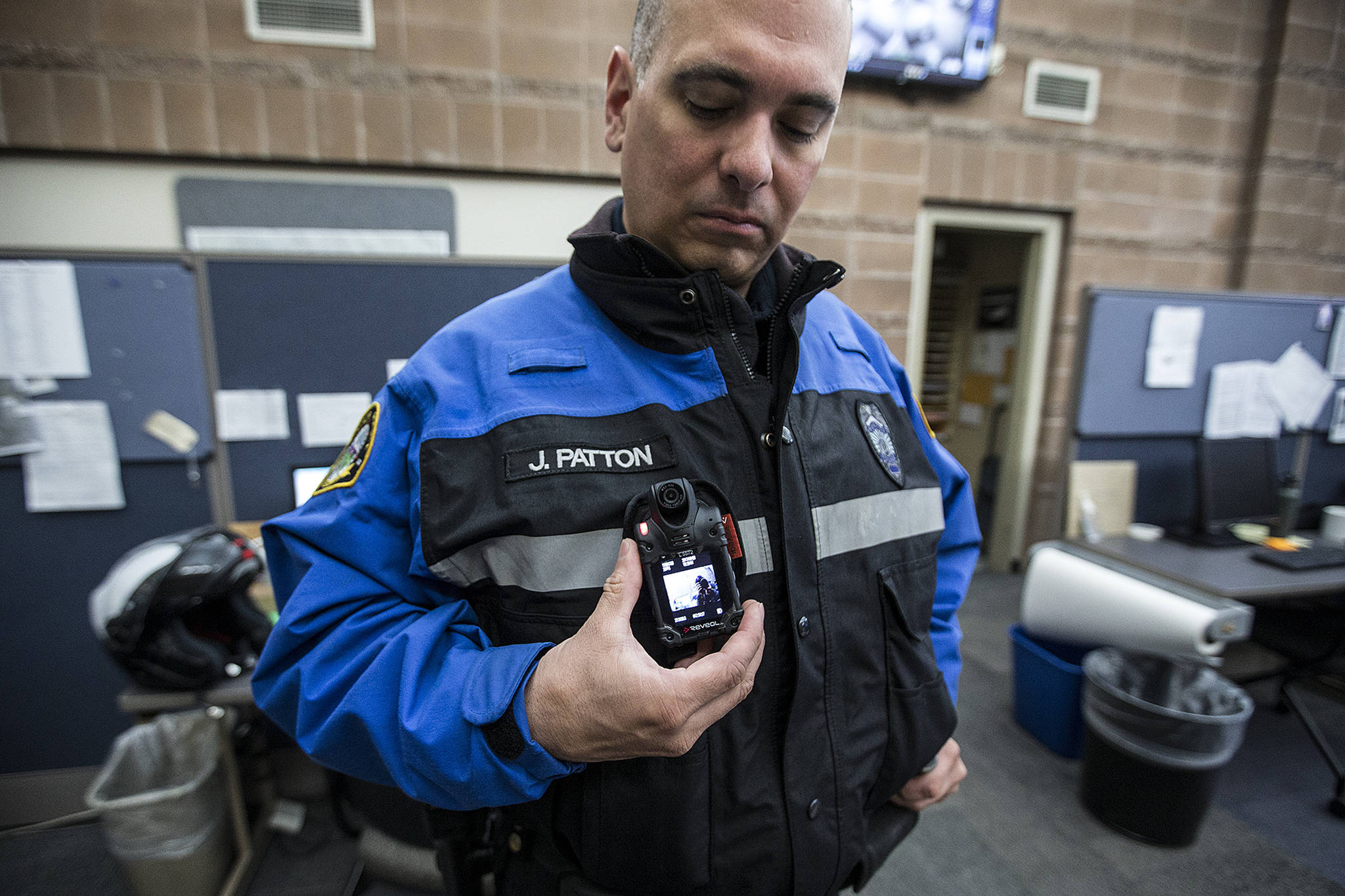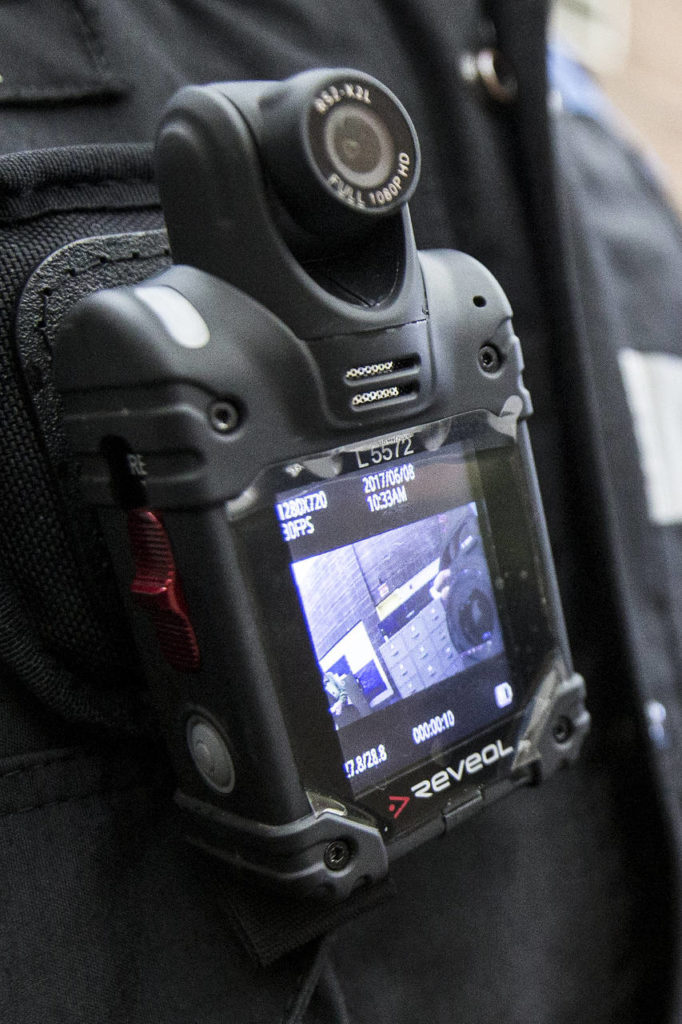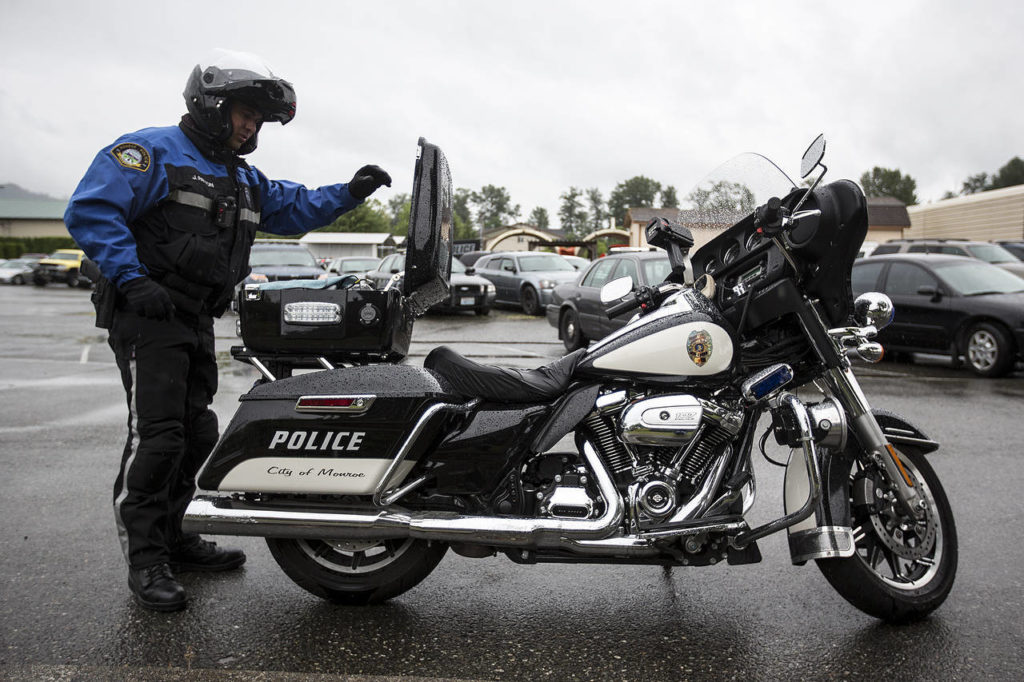MONROE — Eventually it will become muscle memory, like any other part of the job.
Wear the badge. Holster the gun. Turn on the camera.
Five officers at the Monroe Police Department are wearing body cameras, recording devices mounted on their uniform jumpsuits or jackets. They went live in May after a six-month trial period in 2016.
“The public wants transparency, and we want to be transparent,” Deputy Police Chief Ken Ginnard said.
With a force of 33, Monroe has one of the smaller police departments in Snohomish County. Yet it’s the first municipal agency here to add body cameras. Tulalip Tribal police also use the devices. Mill Creek and Lynnwood did trials last year, and Mill Creek is considering implementation.
Seattle’s mayor announced July 17 that he wants to mandate cameras in that city. The proposal has drawn opposition from the officers guild over collective bargaining rights.
The technology has been around for a while, long enough to become part of the national conversation about policing. It’s getting less expensive, though cost concerns remain. It’s also difficult to write policies for body cameras that address every question about privacy and ethics.
The devices have fierce advocates, including many in law enforcement, as well as their critics. Video footage offers accountability in a visual and convincing format, but it doesn’t always provide context. Officer discretion plays a role in how the cameras are used, and when they can be disabled. For local governments, it gets especially complicated with public disclosure and labor contracts.
Much of the video collected becomes a public record. The headache that follows is not just about the sheer size and volume of the digital files. Officers often find themselves witnesses to people’s worst moments — crises involving alcohol, drugs, family disputes, violence, sexual abuse and mental illness. Sometimes children are present. Sometimes police take a life.
That all has to be considered. Videos are easy to post to the Internet.
Tulalip police declined to discuss their cameras. As law enforcement for a sovereign nation, they aren’t subject to state public disclosure laws. Municipal departments don’t have that option.
The Snohomish County Sheriff’s Office receives more than 6,000 records requests a year.
“Not only do we not have the funds in our budget to pay for (cameras), we do not have the resources to manage the storage of the files and the ensuing public records requests,” said Shari Ireton, a sheriff’s spokeswoman. The sheriff’s office in Island County cited similar concerns.
Police in Edmonds, Everett and Mill Creek say they are waiting for clarification from the Legislature. The Lake Stevens police chief believes cameras can exonerate officers from “malicious complaints,” but he wants to observe how the disclosure and privacy issues play out.
“Video brings on a whole new set of demands and challenges,” Edmonds police Sgt. Josh McClure said. “As an agency we know the benefits, but the costs currently outweigh them.”
Furthermore, many aspects of a camera program can be subject to negotiation with police unions. The videos can become part of internal investigations: They could be used as grounds for discipline or even termination.
Video seems to reduce complaints on officers, deputy chief Ginnard said.
“You see if in fact what was alleged actually occurred,” he said.
In Monroe, the police were willing to take on the challenges of cameras, citing the increasing public demand for accountability. They also sought approval from the City Council.
Monroe officers have some discretion on when to turn off the video, Ginnard said. They are asked to consider the dignity of those around them.
For now, they have only five cameras, mainly for cost reasons, department spokeswoman Debbie Willis said. Monroe paid $12,859 total. The price included warranties, support and chargers. It also included software that allows the department to blur or obscure certain faces prior to release.
The officers who wear the devices volunteered. In criminal investigations, the videos are forwarded to prosecutors as potential evidence for charges and trial. As of this writing, the department had neither received records requests for videos nor seen the footage used for prosecution. It’s early, though.
Each work day, the officers place their cameras in a charging station that uploads the files to a server. The amount of time the video must be retained varies. The shortest period allowed is 60 days.
Each camera flashes a red light from the officer’s chest when it is activated. It has a screen, about 2 inches by 2 inches, that faces away from the officer. People can see themselves on video.
So far, people’s eyes seem to be drawn to the screen, said Javier Patton, a motorcycle officer who’s been with the department about a decade. He liked the idea of having video to supplement his reports, he said.
The camera can swivel, and that’s useful during traffic stops, he said. He’s been asked to record every encounter with the public when possible. So far, no one has requested that he turn off his camera, he said.
“I think a lot of people are accepting this,” he said. “They see we are being held accountable.”
As for disclosure, state law draws some lines between what is considered private information and what falls under the public’s right to know. In paper records, police can make redactions with marker. That’s not as simple for a moving image.
A state task force is studying camera issues and a report is due late this year. Meanwhile, Monroe says it is following guidelines on how the video can be released through records requests. There is no blanket rule to blur faces. Legal protections exist for minors and victims of sex crimes or domestic violence.
Records requests are different than discovery for trial. There’s still a lot to sort out.
Another looming question is what happens if a body camera records a police shooting. If a Monroe officer’s camera captured a shooting by another agency, that video would become part of the case file. In some high-profile deaths, including one in Seattle, the officers who opened fire did not have their cameras rolling. When it does exist, video doesn’t always answer every question about what happened.
In recent years, the Snohomish County Multiple Agency Response Team, which investigates when police use fatal force, has begun releasing 911 tapes and emergency radio recordings from shootings.
Detectives and their supervisors routinely decide what information can be made public and when. Sometimes, they argue that disclosure would harm the investigation. That is an exemption legally allowed only while the case is active.
Body camera footage likely would fall under the same rules: SMART would decide when it could be released. In past years, it has sometimes taken months for video recordings from surveillance cameras or witnesses’ cellphones to become public.
Rikki King: 425-339-3449; rking@heraldnet.com. Twitter: @rikkiking.
Police body cameras in and around Snohomish County
Departments using body cameras: Monroe, Tulalip Tribal.
Under consideration: Marysville, Mill Creek (had a test run in 2016).
No plans at this point: Arlington, Bothell, Brier, Edmonds, Everett, Island County Sheriff’s Office, Lake Stevens, Lynnwood (tested them in 2016), Mountlake Terrace, Mukilteo, Snohomish County Sheriff’s Office (service areas include Granite Falls, Snohomish, Stanwood and Sultan), Washington State Patrol, Woodway.
What about dashboard cameras?
Lynnwood used them until September 2015. The Washington State Patrol uses them for nearly every trooper working the roads, but they don’t use body cameras.
Talk to us
> Give us your news tips.
> Send us a letter to the editor.
> More Herald contact information.




























